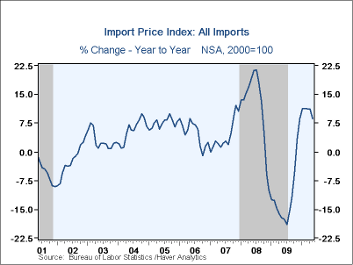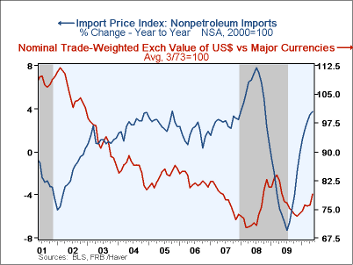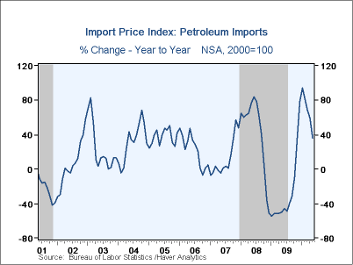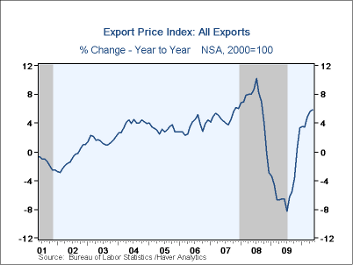 Global| Jun 15 2010
Global| Jun 15 2010U.S. Import Prices Fall With Lower Oil Costs
by:Tom Moeller
|in:Economy in Brief
Summary
U.S. import prices in May posted their second monthly decline this year with lower energy prices. The Bureau of Labor Statistics indicated that, overall, import prices fell 0.6% last month but the decline was short of Consensus [...]
 U.S. import prices in May posted their second
monthly decline this year with lower energy prices. The Bureau of Labor
Statistics indicated that, overall, import prices fell 0.6% last month
but the decline was short of Consensus expectations for a 1.3% drop.
Excluding petroleum, import prices rose 0.5%, the same as the upwardly
revised April increase. During the last twelve months, energy prices
increased by roughly one-third and non-oil import prices rose an
elevated 3.7%.
U.S. import prices in May posted their second
monthly decline this year with lower energy prices. The Bureau of Labor
Statistics indicated that, overall, import prices fell 0.6% last month
but the decline was short of Consensus expectations for a 1.3% drop.
Excluding petroleum, import prices rose 0.5%, the same as the upwardly
revised April increase. During the last twelve months, energy prices
increased by roughly one-third and non-oil import prices rose an
elevated 3.7%.
Petroleum prices fell 5.0% last month and more-than reversed the prior month's increase. Nevertheless, energy prices have risen 4.0% this year following last year's 78.6% increase from December-to-December. Yesterday, Brent crude oil prices rose to $75.15 per barrel, their highest since mid-May.
Non-oil import prices prices continued to reflect the dollar's earlier weakness as well as the firmer U.S. economy. Prices rose 0.5% in May following an upwardly revised 0.5% April increase. As a result, prices rose at a 3.5% annual rate since December and reversed last year's 4.1% decline. (During the last ten years, there has been a negative 81% correlation between the nominal trade-weighted exchange value of the US dollar vs. major currencies and the y/y change in non-oil import prices.)
 Stronger food & beverage prices continued to provide lift to
overall import prices this year with a 1.5% May increase, 12.8% (AR)
gain YTD. That compares to a 2.8% decline during 2009. Prices for
nonauto consumer goods also have turned and risen at a still-modest
0.7% rate this year after a 0.3% decline last year.
Appliance prices
have strengthened at a 5.3% rate after last year's more modest
increase. Apparel prices have risen at a 0.5% annual rate after no
change last year. Imported auto prices fell at a 1.1% rate YTD after a
0.4% uptick last year.
Capital goods slipped 0.5% YTD and
excluding computers also slipped 0.4% YTD following a 0.7% gain last
year.
Stronger food & beverage prices continued to provide lift to
overall import prices this year with a 1.5% May increase, 12.8% (AR)
gain YTD. That compares to a 2.8% decline during 2009. Prices for
nonauto consumer goods also have turned and risen at a still-modest
0.7% rate this year after a 0.3% decline last year.
Appliance prices
have strengthened at a 5.3% rate after last year's more modest
increase. Apparel prices have risen at a 0.5% annual rate after no
change last year. Imported auto prices fell at a 1.1% rate YTD after a
0.4% uptick last year.
Capital goods slipped 0.5% YTD and
excluding computers also slipped 0.4% YTD following a 0.7% gain last
year.
Total export prices continued firm with a 0.7% increase last month after a 1.2% April gain. The rise reflected a 0.6% gain (8.2% YTD) in non-agricultural export prices and a 1.4% jump in agricultural goods prices (0.3% YTD).
The import and export price series can be found in Haver's USECON database. Detailed figures are available in the USINT database.
The Global Recovery and Monetary Policy is this morning's speech by St. Louis Fed President James Bullard and it can be found here.
Tom Moeller
AuthorMore in Author Profile »Prior to joining Haver Analytics in 2000, Mr. Moeller worked as the Economist at Chancellor Capital Management from 1985 to 1999. There, he developed comprehensive economic forecasts and interpreted economic data for equity and fixed income portfolio managers. Also at Chancellor, Mr. Moeller worked as an equity analyst and was responsible for researching and rating companies in the economically sensitive automobile and housing industries for investment in Chancellor’s equity portfolio. Prior to joining Chancellor, Mr. Moeller was an Economist at Citibank from 1979 to 1984. He also analyzed pricing behavior in the metals industry for the Council on Wage and Price Stability in Washington, D.C. In 1999, Mr. Moeller received the award for most accurate forecast from the Forecasters' Club of New York. From 1990 to 1992 he was President of the New York Association for Business Economists. Mr. Moeller earned an M.B.A. in Finance from Fordham University, where he graduated in 1987. He holds a Bachelor of Arts in Economics from George Washington University.








